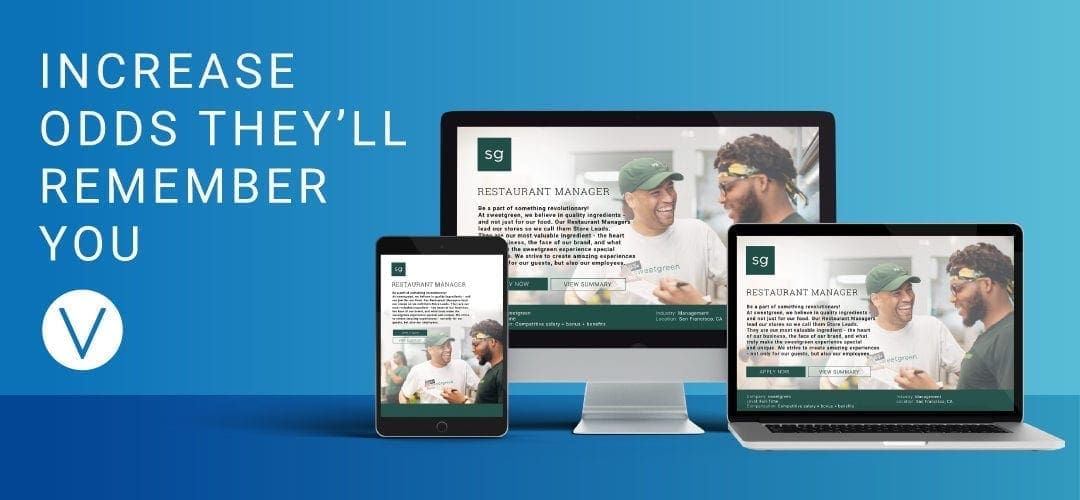 It’s safe to say the world is powered by visuals. The way we communicate with each other is increasingly visual, from live chatting with loved ones on FaceTime to live feeds on Facebook, Snapchat and Instagram. We connect to other people, places and even brands, through face-to-face interactions, through visuals. Despite the world’s continuous visual communication evolution, HR recruitment, particularly job postings and visual recruitment, have failed to follow suit. As a result, recruitment tactics are far behind. We make strides in improving the candidate experience, beef up our ATS and continue to look for ways to connect authentically with potential employees.
It’s safe to say the world is powered by visuals. The way we communicate with each other is increasingly visual, from live chatting with loved ones on FaceTime to live feeds on Facebook, Snapchat and Instagram. We connect to other people, places and even brands, through face-to-face interactions, through visuals. Despite the world’s continuous visual communication evolution, HR recruitment, particularly job postings and visual recruitment, have failed to follow suit. As a result, recruitment tactics are far behind. We make strides in improving the candidate experience, beef up our ATS and continue to look for ways to connect authentically with potential employees.
It’s not just the most innovative, cutting-edge companies or tech nerds who are communicating this way. This level of connecting is quickly becoming “business as usual” and as a result people expect to feel connected from the get-go. With the click of a mouse or press of a button, people expect to get the information they want through their own experiences and that of others. When we see a story, we feel instantly connected on a human level.
Visual Story Telling
Oftentimes, we rely on our company’s website or marketing efforts to tell the visual story of our brand. We assume (or at the very least, hope) that potential candidates are coming to our company’s website or engaging with us on social media. For companies with stellar marketing departments and an engaged employee referral network, this may be enough to successfully communicate your employer brand. For passive candidates to just “get” what your company is all about.
However, HR managers often overlook the opportunity to use the job posting itself to visually tell the story of the company’s brand and to engage with potential candidates in a meaningful way. The power of visuals in recruiting has been a hot topic on the HR scene for awhile now. Subconsciously, we get it. We understand that people connect deeper when they see something and as a result it improves retention and comprehension. That’s only the tip of the iceberg!
Check out some of the other benefits of including visuals in job postings:
Stand out in a sea of sameness
If you’ve seen one job posting, you’ve seen them all. They all look and sound similar. HR recruiters want to source top, high-quality candidates, so it’s essential to differentiate yourself from the pack.
“Most employment branding and recruitment marketing processes are still dominated by text. Look at most corporate career pages. Look at any job posting. Look at offer letters, onboarding packets, etc. If you’re just using text heavy candidate outreach emails and bullet-point job descriptions, you’re getting ignored by the candidates you need to build relationships with. Monster, for example, has over 1 million job postings at any given time. You won’t have conversions unless candidates see your message.” (Chris Murphy, Glassdoor.com)
Engage authentically
Visuals automatically resonate with people because it sparks an emotional connection. When you use visuals in job postings, people can start to connect with your company. They can start to visualize themselves working there, making connections with colleagues and even doing the job.
Increase odds they’ll remember you
A few stats on visuals: 40% of people respond better to visual content versus plain text. 90% of information transmitted to the brain is visual. 50% of our brain is active in processing visuals. 70% of our sensory receptors are in our eyes.
This means that people scientifically respond better to visuals. Think of how many emails you get on a daily basis. Imagine scrolling through your Facebook or Twitter feed. As humans, we’re inundated with content and can become overloaded quickly. Make sure the odds are in your favor when it comes to creating a job post. Adding photos of your workplace, a short 10- 30 second video introduction or testimonials from employees paints an authentic picture for potential candidates.
Overall, the use of visuals in job postings can only help when it comes to attracting quality candidates who may or may not be job searching. It’s essential for companies to meet people where they are and not expect them to consistently conform to the status quo. The companies who innovate and think outside of the box ultimately attract the movers and shakers that make a difference.

